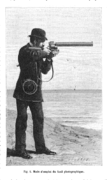|
Étienne-Jules Marey
 Étienne-Jules Marey (French: [etjɛn ʒyl maʁɛ]; 5 March 1830, Beaune, Côte-d'Or – 15 May 1904,[1] Paris) was a French scientist, physiologist and chronophotographer. His work was significant in the development of cardiology, physical instrumentation, aviation, cinematography and the science of laboratory photography. He is widely considered to be a pioneer of photography and an influential pioneer of the history of cinema. He was also a pioneer in establishing a variety of graphical techniques for the display and interpretation of quantitative data from physiological measurement.[2] Biography  Marey started by studying blood circulation in the human body. Then he shifted to analyzing heart beats, respiration, muscles (myography), and movement of the body. To aid his studies he developed many instruments for precise measurements. For example, in 1859, in collaboration with the physiologist Auguste Chauveau and the watch manufacturer Breguet, he developed a wearable Sphygmograph to measure the pulse. This sphygmograph was an improvement on an earlier and more cumbersome design by the German physiologist Karl von Vierordt.[3] In 1869 Marey constructed a very delicate artificial insect to show how an insect flies and to demonstrate the figure-8 shape it produced during movement of its wings. He fixed a gold foil to an insect wing and shone light on it to study the flapping of the wing. He also used a soot covered glass-fibre introduced along the path of the insect wing to determine if it crossed with the wing in the upper stroke or lower stroke by examining the side on which the soot was cleared.[4] Then he became fascinated by movements of air and started to study bigger flying animals, like birds. He adopted and further developed animated photography into a separate field of chronophotography in the 1880s. His revolutionary idea was to record several phases of movement on one photographic surface. In 1890 he published a substantial volume entitled Le Vol des Oiseaux (The Flight of Birds), richly illustrated with photographs, drawings, and diagrams. He also created stunningly precise sculptures of various flying birds. Marey studied other animals too. He published La Machine animale in 1873 (translated as "Animal Mechanism"). The English photographer Eadweard Muybridge carried out his "Photographic Investigation" in Palo Alto, California, to prove [dubious – discuss] that Marey was right when he wrote that a galloping horse for a brief moment had all four hooves off the ground. Muybridge published his photos in 1879 and received some public attention. Marey hoped to merge anatomy and physiology. To better understand his chronophotographic images, he compared them with images of the anatomy, skeleton, joints, and muscles of the same species. Marey produced a series of drawings showing a horse trotting and galloping, first in the flesh and then as a skeleton. The presence and activity of Marey in Naples is well documented,[5] in particular thanks to the documentation preserved in the historical archive of the Stazione Zoologica Anton Dohrn. Marey began to travel to Naples presumably because of his relation with madame Vilbort, wife of Joseph Vilbort, the director of the French journal Le Globe. Madame Vilbort moved to Naples to cure her illness, thanks to the warm climate, and Marey followed her. Marey and madame Vilbort bought villa Maria in Posillipo in 1880. Marey accomplished in Naples part of his studies aimed at the realization of his pre-cinematographic tools and in the Dohrn zoological station studied the movement of fishes hosted in the aquarium's tanks. In a letter dated 1 November 1876 Marey requested the Stazione Zoologica to provide live ray fishes for his studies. Among the documentation that witnesses the collaboration of Marey with Anton Dohrn is the archive at the zoological station which preserves photos where the two appear together during an excursion and show Marey on board Dohrn's boat. The usage of the chronophotographic gun, which Marey used to aim at birds, but without shooting, appeared unusual to local people who referred to Marey sometimes as the "silly from Posillipo" ("lo scemo di Posillipo").[6] He proposed "Marey's Law", a law that stated that an increase in blood pressure caused a lowering of the heart rate and vice versa.[7] He also invented "Marey's tambour" for physiological experiments.[8] ChronophotographyMarey's chronophotographic gun was first made in 1882.[9] This instrument was capable of taking 12 consecutive frames a second, with all the frames recorded on the same picture. Using these pictures he studied horses, birds, dogs, sheep, donkeys, elephants, fish, microscopic creatures, molluscs, insects, reptiles, etc. Some call it Marey's "animated zoo". Marey also conducted the famous study about cats always landing on their feet. He conducted very similar studies with a chicken and a dog and found that they could do almost the same. Marey also studied human locomotion. He published another book Le Mouvement in 1894. Marey's chronophotographic gun
In 1885 Marey mentioned how he could playback the animation from his gun using the phenakistiscope.[10] In 1889 he developed the chronophotographe camera which took images on film at even spacing. He however did not manage to play it back as he was unable to move between the frames in an even manner. Edison visited Marey in 1889 and was able to solve the problem using a sprocketed film advance mechanism along with W.L. Dickison who was developing something using the cylindrical model of the phonograph.[11] Towards the end of his life he returned to studying the movement of quite abstract forms, like a falling ball. His last great work was the observation and photography of smoke trails. This research was partially funded by Samuel Pierpont Langley under the auspices of the Smithsonian Institution, after the two met in Paris at the Exposition Universelle (1900). In 1901 he was able to build a smoke machine with 58 smoke trails. It became one of the first aerodynamic wind tunnels. Bibliography
See also
References
External linksWikimedia Commons has media related to Étienne-Jules Marey.
|


